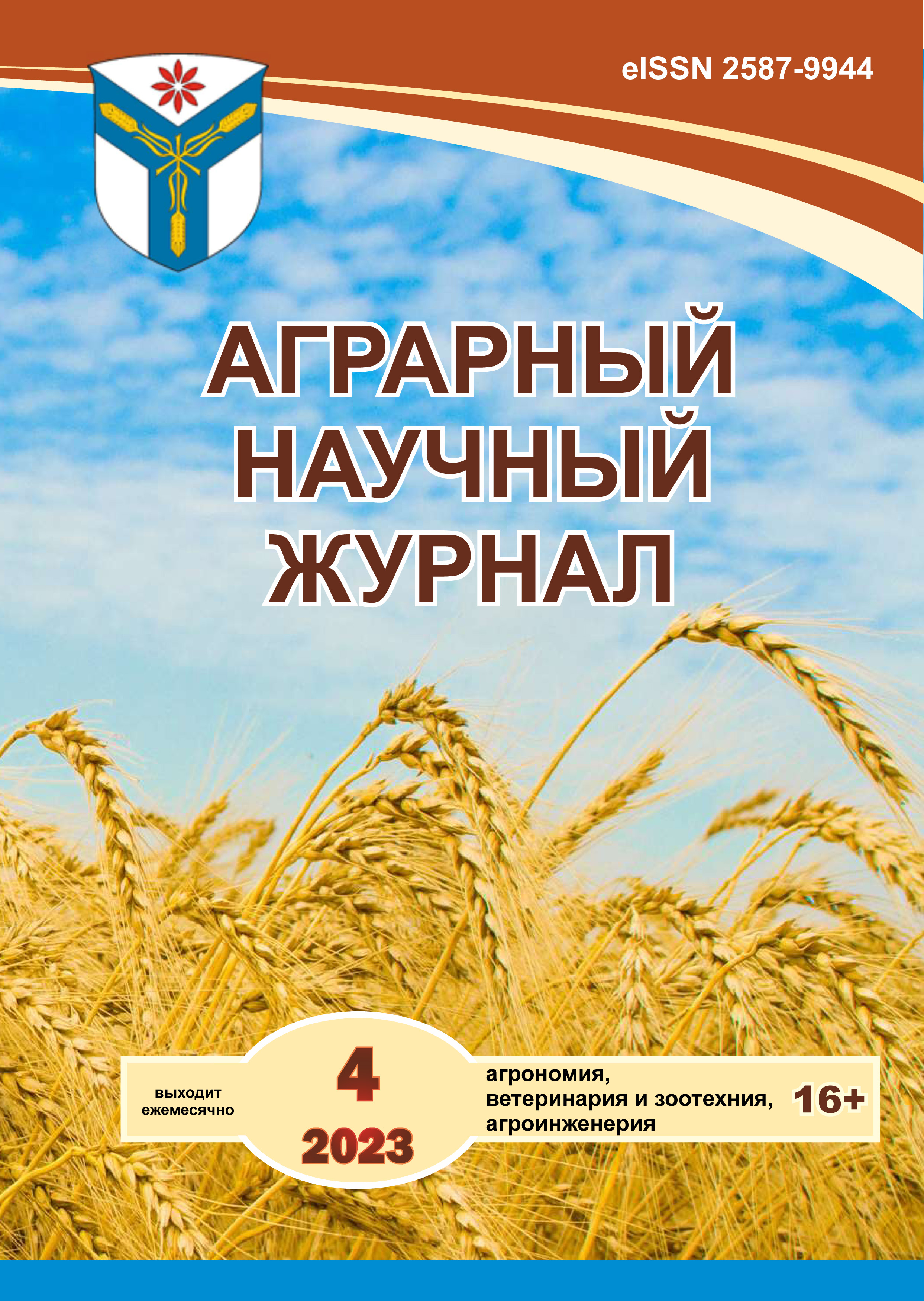Monitoring of the flight of aphids on potato plantations in the Arkhangelsk region
DOI:
https://doi.org/10.28983/asj.y2023i4pp28-33Keywords:
aphids, vectors of viruses, potatoes, flight monitoring, population dynamicsAbstract
The results of the catch of aphids in vegetative plantings of potatoes in 2018–2021 are presented. The studies were carried out in the southern part of the Arkhangelsk region (Kotlas region). Yellow water traps were used to catch winged aphids. It was revealed that 25 species of winged aphids migrate to potato plantations with an average annual number of 162 individuals during the growing season. Of the total number, 7 species of aphids carrying potato viruses were identified. These included Acyrthosiphon pisum Harr., Aphis fabae Scop., Aphis nasturtii Kalt., Aulocarthum solani Kalt., Hyperomyzus lactucae L., Macrosiphum euphorbiae Thomas, and Rhopalosiphum padi L. These species account for 70 to 82% of the abundance structure. Not a single individual of the most harmful species Myzus persicae Sulz was caught. In the group of virus-carrying aphids, the most numerous species are R. padi L. (an average of 48 individuals per season) and A. fabae Scop. (an average of 35 individuals per season). It has been established that the flight of aphids is largely influenced by average daily air temperatures. In the conditions of the hottest year (2021) at an average daily air temperature of 19 °C, the largest annual number of aphids was identified - 181 individuals. Winged aphids are present in potato agrocenoses throughout the entire growing season, which indicates the need for annual monitoring of their numbers and the use of protective measures.
Downloads
References
Анисимов Б. В. Фитосанитарные зоны и их роль в безвирусном семеноводстве картофеля // Защита и карантин растений. 2014. № 11. С. 14–19. Режим доступа: https://elibrary.ru/item.asp?id=22400430.
Берим М. Н. Тли на картофеле // Защита картофеля. 2015. № 2. С. 13–15. Режим доступа: https://elibrary.ru/item.asp?id=26192234.
Биологическая защита меристемного семенного картофеля от вредителей-переносчиков вирусов в закрытом грунте / В. Н. Зейрук [и др.] // Защита картофеля. 2017. № 4. С. 3–12. Режим доступа: https://elibrary.ru/item.asp?id=32529788.
Екатеринская Е. М., Тайков В. В., Карпова О. В. Особенности лёта тлей на посадках оздоровленного картофеля, выращиваемого в Костанайском НИИСХ // Защита картофеля. 2016. № 1. С. 3–5. Режим доступа: https://elibrary.ru/item.asp?id=28140709.
Зыкин А. Г. Вирусные болезни картофеля. Л.: Колос, 1976. 152 с.
Лайнгер Б. Б. Тли – переносчики вирусов и прогнозирование сроков их появления на семеноводческих посадках картофеля: автореф. дис. … канд. с.-х. наук . М., 1977. 14 с.
Лапшинов Н. А. Распространение вирусной инфекции картофеля в зоне подтайги предгорий Кемеровской области // Достижения науки и техники АПК. 2011. № 1. С. 32–33. Режим доступа: https://elibrary.ru/item.asp?id=16333612.
Махоткин А. Г., Гричанов И. Я., Овсянникова Е. И. Водные ловушки для учёта двукрылых насекомых // Защита и карантин растений. 2001. № 8. С. 36. Режим доступа: https://elibrary.ru/item.asp?id=2886090.
Сабирова Р. М., Сафиуллина Г. Ф., Ахмадеева З. А., Паутова Г. Г. Векторная активность крылатых тлей на посадках картофеля в условиях Предкамской зоны Республики Татарстан // Вестник Казанского ГАУ. 2019. № 4. С. 96–101. DOI: 10.12737/2073-0462-2020-96-101.
Вирус Y-картофеля в Северо-Западном регине РФ: распространение, штаммовый состав и профилактика вызываемых им заболеваний: автореф. дис. … канд. биол. наук. СПб.; Пушкин: ВИЗР, 2005.19 с.
Технологический процесс производства оригинального, элитного и репродукционного семенного картофеля. Практическое руководство / ФГБУ «Россельхозцентр»; под общ. ред. А. М. Малько, Б. В. Анисимова. М., 2017. 64 с.
Ториков В. Е., Величко П. А. Динамика распространения крылатых тлей на посадках картофеля // Вестник Брянской государственной сельскохозяйственной академии. 2020. № 1(77). С. 21–26. Режим доступа: https://elibrary.ru/item.asp?id=42349501.
Шаманин А. А., Корелина В. А., Попова Л. А., Берим М. Н. Изучение видового состава тлей-переносчиков вирусов на посадках картофеля в Архангельской области // Вестник защиты растений. 2017. № 4 (94). С. 63–67. Режим доступа: https://elibrary.ru/item.asp?id=30792838.
Шапошников Г. Х. Подотряд Aphidinea – тли // Определитель насекомых Европейской части СССР. М.,1964. Т.1. С. 489–616.
Moericke V. Eine Farbfallezur Kontrolle des Fluges von Blattl?usen, insbesondere der Pfirsichblattlaus, Myzodes persicae (Zulz) // Nachrichtenblatt des Deutschen Pflanzenschutzdiensten. 1951. No. 3. S. 23–24.
Remaudiee G., Seco Fernandez M. V. Claves de pulgonesalados de la region Mediterranea. Universidad de Leon. 1990. 2. 205 p.
Downloads
Published
Issue
Section
License
Copyright (c) 2023 The Agrarian Scientific Journal

This work is licensed under a Creative Commons Attribution-NonCommercial-NoDerivatives 4.0 International License.








